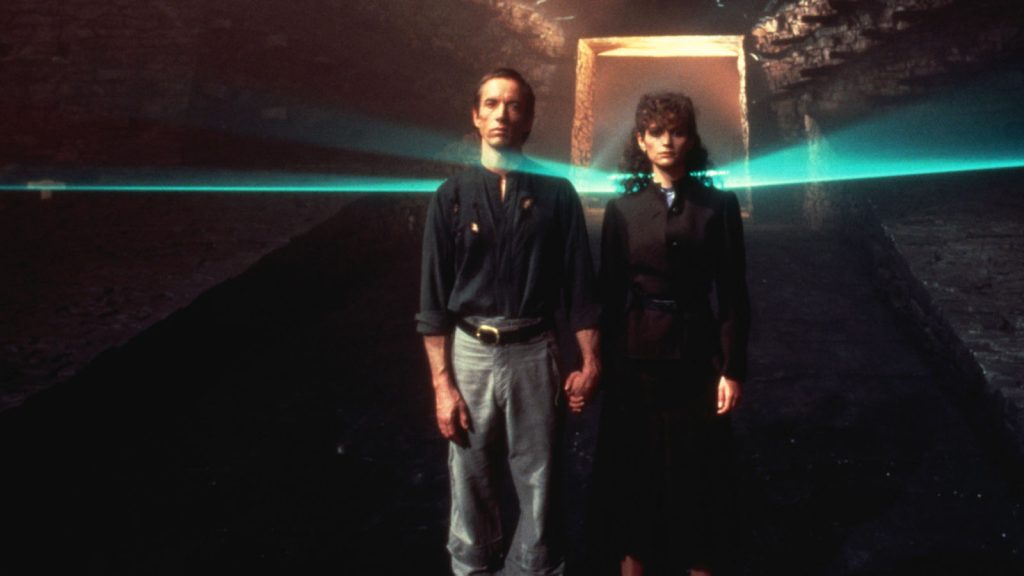
Movies don’t save lives, but they do relitigate memory and imagination. The beloved suddenly reappears in frame, reanimated through some alchemical bargain of light and motion. Isn’t he dead? Yes, in 1978, at the age of 54, Edward D. Wood Jr. died—where else?—in Hollywood. But then, there he is, up on the screen in Ed Wood (1994). Ed in angora, Ed in anguish. Ed tossing back whiskeys, Ed without the too-soon, too-bleak alcoholic ending we know to be inevitable in his story. Ed and Bela Lugosi, legends rising up from open coffins, making another monster movie, maniacal smiles and alive, still.
In 1994, it was fair to speculate whether Tim Burton was a good steward for the myth-life of Wood, seeing as Burton was most recently known for his surprise-boffo Batman adaptations, miracles of personal execution that were both fussy and fetishistic demonstrations of the auteur’s pop-Goth sensibilities. They feel like proof that the dollhouse tinker-spirit Burton displayed on Beetlejuice (1988) and Edward Scissorhands (1990) could be recombined with a genuine box-office instinct for kinetic spectacle. Burton’s pre–Ed Wood films are elaborate and assured in how they enact the ephemerality of dreams in the material world of production design. What would a style-first crafter like Burton do with the life of Wood, whose film art is—largely and divinely—craftless?
First, Burton nudged Scott Alexander and Larry Karaszewski’s life-story screenplay toward the weirdo-punk hop of his debut feature, Pee-wee’s Big Adventure (1985), revealing a strain of humanism humming just so under his early Edward Gorey model homes: here is a hearty portrait of an artist treading every margin, too queer to sit still even in word containers like “queer.” Ed Wood (Johnny Depp) is a Hollywoodland gopher, dutifully moving plant props for hack directors by day and directing his friends, neighbors, and lovers in deeply felt, herky-jerky stage shows by night. When schlockmeister George Weiss (Mike Starr) moves to adapt Christine Jorgensen’s story at his poverty row studio, Ed insists he’s the perfect man to direct the would-be quickie—I Changed My Sex!—on account that the otherwise All-American-presenting Ed has been dressing in women’s clothing on and off for most of his adult life. “Are you a fruit?” Weiss asks. “No, no, not at all,” Ed says. “I love women. Wearing their clothes makes me feel closer to them.” Weiss shrugs and proceeds to deny Ed the job based on the young filmmaker’s lack of experience rather than any confessed proclivities.

It’s the warm, commonsense presentation of cross-dressing that is fundamental to Burton’s conception. Cross-dressing is something Ed does. Ed Wood marks maybe the last time Depp believably traded in earnest tones. It’s easy to dismiss his performance as merely plucky, but the Mickey Rooney aw-shucksing always feels more willed than effortless for both the fictional almost-Ed and the actor embodying him. Living is no easier than making movies. There is always friction. But Depp, Ed, and Burton converge in a kind of devotional ode to the artistic process. And rather than hand-wring over “good” or “bad,” Ed Wood simply and fundamentally believes that the making of art is not only natural but as essential as sustenance or company. (Indeed, these may all be different words for the same thing.) And so it is about cross-dressing. It is a fact never something to be joked about, leered over, or mistrusted—even a cadre of Baptist minister backers on Ed’s Plan 9 from Outer Space (1959) seem more bewildered by the timing of Ed’s outfit change during a stressful on-set moment than the fact of it. In life, Wood’s true desires around gender remained fluid. He dressed in men’s and women’s clothing, had relationships with women, and maintained a half-public, semi-fantastic, maybe-drag alter ego, “Shirley.” The most honest existent statement of Wood’s desires might be Glen or Glenda (1953) itself, which articulates a personal theory of queerness so fundamentally experimental as to necessitate avant-garde language to exist at all in America. Ed Wood is not an experimental film, and Burton is no queer theorist. But by presenting Wood’s cross-dressing as a nearly essence-ial thing, Ed Wood becomes a genuine fantasy of the ’50s it presents, the ’90s it was released into, and the American present. It imagines a world where a figure like Wood is afforded the same dignity, life, and legacy that his more milquetoast, profit-minded contemporaries were accorded.
Ed gets that directing job, mostly because he runs into Bela Lugosi (Martin Landau) in a coffin shop and leverages his new friend as a bona fide star for Weiss’s bargain-basement production. Bela is old and cranky, a methadone addict unable to book jobs until Ed gleefully absorbs him into his growing troupe of outcasts that includes or will include misfits like Bunny Breckinridge (Bill Murray), the Amazing Criswell (Jeffrey Jones), Tor Johnson (George Steele), and Vampira (Lisa Marie). Landau won an Oscar for his portrayal of the Hungarian actor; lest it feel uncouth to honor Wood’s sublimely low and lowly sublime legacy with such bourgeois pleasantries, be assured that Ed Wood’s Bela is as catty as it is celebrational, more “Karloff doesn’t deserve to smell my shit!”s than reverent Dracula enshrinements. Bela is the heart that pumps Ed Wood, and a scene where Landau/Bela restages Wood’s Bride of the Monster dialogue in the black-and-white L.A. sunshine enacts Ed Wood’s thesis in miniature: from another angle, trash is transcendent.
As Bela’s condition worsens throughout the film, it becomes apparent that Ed Wood smuggles a monster inside the monster movie, as Bela drags with him the specter of addiction that afflicted both the real-life Wood and Lugosi. Burton shoots a mid-film rehab visit as if it’s Seconds (1966) or Shock Corridor (1963), a jagged shock of body-in-horror that violates the film’s otherwise optimistic spirit. Just as Wood himself dragged the faux-folksy Eisenhower-era instructional video for his speculative wish fantasia, Glen or Glenda, Burton smuggles in some of the Atomic Age’s drug addiction socio-chiller, a dash of Touch of Evil (1958) swirled in his own loving ode. So jarring is Bela’s exit from the film that the triumphant ending—which runs through a fictional meeting with Orson Welles and the liberating production and rapturous premiere of Plan 9 from Outer Space—feels a bit like a dream sequence. Ed Wood can’t save Ed Wood, who moved from Hollywood’s periphery to its gutter like so many of its other dreamers. In telling his story in loving, mythic terms, Burton mounts a thesis on artmaking as subtly radical as the images Wood himself authored: what if some people’s great art is the act of gathering? Ed Wood’s art was giving the weirdos a movie to live in, a certain grace that occurs only when you move a camera over someone to save them, at least for a little while. 🩸

is a New Jersey–based writer. He’s an Associate Editor at Bright Wall/Dark Room, and his writing has appeared in Reverse Shot, MUBI Notebook, the Los Angeles Review of Books, and elsewhere.
Even after the financial success of Tim Burton’s 1985 feature debut, Pee-wee’s Big Adventure, Warner Bros. rejected his vision for Batman and he was left in search of a follow-up.
BY ANN OLSSON | March 17, 2023
One of the most unheralded of Universal’s 1930s horror films, though perhaps the purest example of the form during that era...
BY LAURA KERN | November 13, 2024
A paragon of queer perversity, Edgar G. Ulmer’s unfathomable Universal horror hit gave major stars Bela Lugosi and Boris Karloff two of their greatest roles.
BY MICHAEL KORESKY | June 13, 2022

This pre-Code offering packs a lot of story into its typically brisk running time, with several plot threads weaving together a (not always successful) tapestry of spooky and criminal doings.
READ MORE >
BY ANN OLSSON | Month 00, 2021

In what could be the fastest-resulting rape revenge movie, a drunken lout brutally forces himself on Ida, the young woman who doesn't return his affections, during a party over Labor Day.
READ MORE >
BY LAURA KERN | Month 00, 2021

Beast is a lot of movies in one package - fractured fairy tale, belated-coming-of-age story, psychological drama, regional horror film - but above all it's a calling card for its leading lady, Jessie Buckley.
READ MORE >
BY LAURA KERN | Month 00, 2021